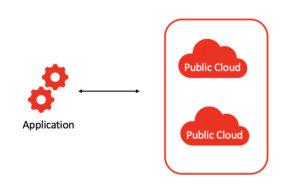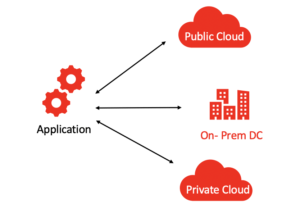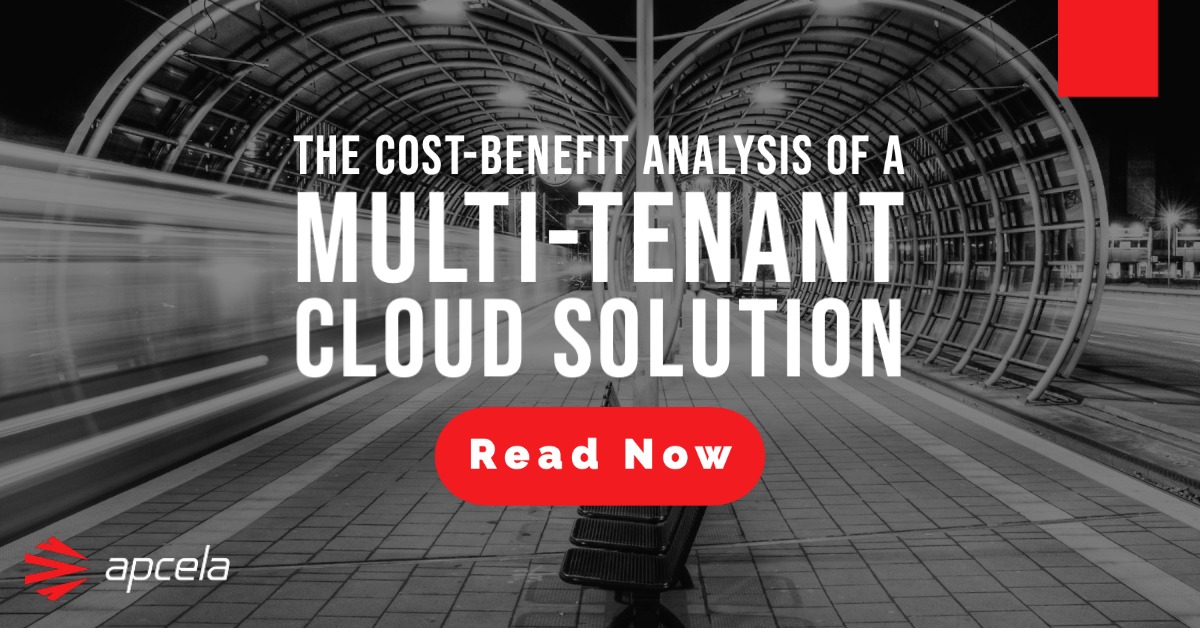Apcela’s Definition Deep Dive Series
Section 1: Overview of Multicloud
First of all, Multicloud is an approach or architecture – a cloud strategy – rather than a product. At its core, Multicloud is the use of multiple cloud computing and storage services sourced from more than one vendor in a single architecture. This can be public or private, but usually refers to utilizing two or more public cloud as well as multiple private clouds. Essentially, with such a distribution of cloud services, the aim is to eliminate the reliance on any single cloud provider while also increasing the scope and spread of services.

Multicloud consists of multiple clouds (typically public) from more than one provider
A Multicloud approach enables organizations to select the most optimal CSPs (Cloud Services Providers) for a given function or application architecture requirement. As the capabilities, compatibility, and cost structures for similar functional constructs vary among the CSPs, Multicloud approach offers the best-of-breed capabilities, selection of the most cost-effective provider for the job, and helps avoid vendor lock-in. In addition to the type of applications, the CSP selection also varies based on the organization’s size, budget, industry vertical, region, and existing familiarity or expertise.
In a recent Gartner survey of public cloud users, 81% of respondents said they are working with two or more cloud providers. – “Why Organizations Choose Multicloud Strategy,” Gartner
Section 2: Why more companies are adopting a Multicloud strategy
Reasons for deploying a Multicloud architecture are varied, but include reducing reliance on any single vendor for failover (especially when it comes to customers asking for features via multiple vendors with proprietary solutions), cost-efficiencies, increasing flexibility, compliance for regional policies, geographic distribution for proximity to reduce latency, and disaster mitigation. It is an exception to the trend towards consolidating all services under a single vendor and seeks to utilize a best-of-breed solution that acknowledges that no one provider can provide everything for everyone. However, many enterprises still employ an integrator to manage the combination of tools and vendors, even though synchronization of vendors is not essential.
Section 3: Hybrid Cloud vs. Multicloud
Multicloud differs from “hybrid cloud” architectures – which refer to multiple deployment modes of cloud (such as public, private, and legacy) rather than multiple cloud service providers. They can be of the same deployment type (such as two public clouds), but are integrated. Hybrid Cloud and Multicloud tend to be used distinctly – if the clouds are interconnected, they are hybrid, and if they are not, Multicloud – though the two methods can certainly can incorporate features of the other, with more complex considerations. Both methods are increasingly popular as having multiple cloud deployments is becoming more common across enterprises as they seek to improve security and performance while expanding environments.

“Hybrid cloud” refers to utilizing two or more distinct types of infrastructure: it combines a private cloud, an on-premises data center, or both with at least one public cloud.
Section 4: What are the different types of Multicloud?
Subsection 4.1: On-demand Multipurpose Cloud Services
On-demand computing is a business computing model in which related resources are made available to users on an “as needed” basis, rather than all at once. This offers more flexibility to customers as computing demands fluctuate in an unpredictable environment.
The different types of cloud computing services include Software as-as-Service (SaaS), Infrastructure as-a-Service (IaaS), Platform as-a-Service (PaaS), Function as-a-Service (FaaS), and more.
Subsection 4.2: Hybrid Infrastructure
As stated above, though Hybrid Cloud differs from Multicloud, they can work together for a more complex solution.
“One common misconception when looking at hybrid vs multi-cloud infrastructures is that the two are mutually exclusive. The explicit definition of a multi-cloud environment, more than one, suggests that a hybrid cloud model is also indeed a multi-cloud model. However, the inverse is not always true. A multi-cloud configuration can be hybridized but it can also exist without the need for individual clouds to talk to each other.” – Nutanix
Section 5: The Advantages to a Cloud Strategy for Multiple Platforms
Key benefits for your business include full feature network and security functions in a standardized transit architecture. This means full preservation of security controls between the cloud and on-prem networks. Further, this reduces network latency and improves performance, as users and sites can directly connect to the transit network at cloudhubs to connect to Cloud/SaaS applications. On top of this, a Multicloud architecture can significantly reduce costs related to networking, security and transit. For example, there is only need for a single network and security stack at the Multicloud boundary, there is no hair pinning of the traffic to an on-prem data-center based stack, and it is directly accessible by users and branches via any available connectivity mechanism, in a latency optimized manner. Customers can even use internet as the ‘last mile’ to reach cloudhubs from corporate locations or home offices, using VPNs, remote access clients, SD-WAN over the Internet, or GRE tunnels. Or, the hubs can be made nodes on the MPLS network via extension.
Section 6: Choosing the Right Cloud Providers for Your Business
During countless discovery calls, design & engineering sessions, and technical discussions with customers and prospects, the Apcela team of engineers and architects have discovered that a majority of customers would like to have a select group of vendors provide various functional stacks for Multicloud. You can pick your choice of vendor for each feature, such as Vendor A for data analytics and Vendor B for collaboration and messaging, and have it managed under one Multicloud platform, rather than defaulting to Vendor X for everything. This is how we at Apcela approach our plug and play offering on our Arcus platform.
Section 7: Migrating to a Multicloud Strategy
As with most technological evolutions, migrating to Multicloud can be challenging, as it requires enterprise teams to research multiple service providers. Further, different cloud services and platforms may require distinct strategies for implementation – with different skills and capabilities need for migration. You can avoid hiring an entirely new team of cloud-ready engineers by turning to a cloud-agnostic integrator service provider such as Apcela.
Section 8: How Apcela can help you
The Apcela Arcus Platform is expanding to include a Multicloud connectivity and orchestration Solution. The solution incorporates private fiber connectivity to Cloud/SaaS regions (cloud on-ramps), and orchestration of standardized network and security transit architectures at the AppHubs and in public CSP infrastructure to offer the most cost optimal means of achieving multi-cloud connectivity while maintaining security and compliance requirements.
The Arcus Platform enables enterprises to seamlessly integrate core data centers, regional offices, and remote users with SaaS and IaaS Providers, all as a service. With a software-defined approach and the ability to push security to the edge, Arcus extends the traditional enterprise WAN to the cloud.
We at Apcela want to help enterprises avoid the pitfalls of single-vendor reliance and have relationships with a number of cloud providers right at the source. Our AppHubs can lift and shift existing stacks to avoid changes within vendor relationships and can manage this all with minimal changes in your teams’ day to day while fulfilling the improvements you seek. See more in our upcoming Arcus Multicloud Solution brief, or feel free to contact us.
Sources:
- https://www.gartner.com/smarterwithgartner/why-organizations-choose-a-multicloud-strategy
- https://www.atlantic.net/life-sciences-pharma-biotech/on-demand-computing-advantages/
- https://www.vxchnge.com/blog/different-types-of-cloud-computing
- https://www.nutanix.com/blog/hybrid-cloud-vs-multi-cloud-whats-difference


